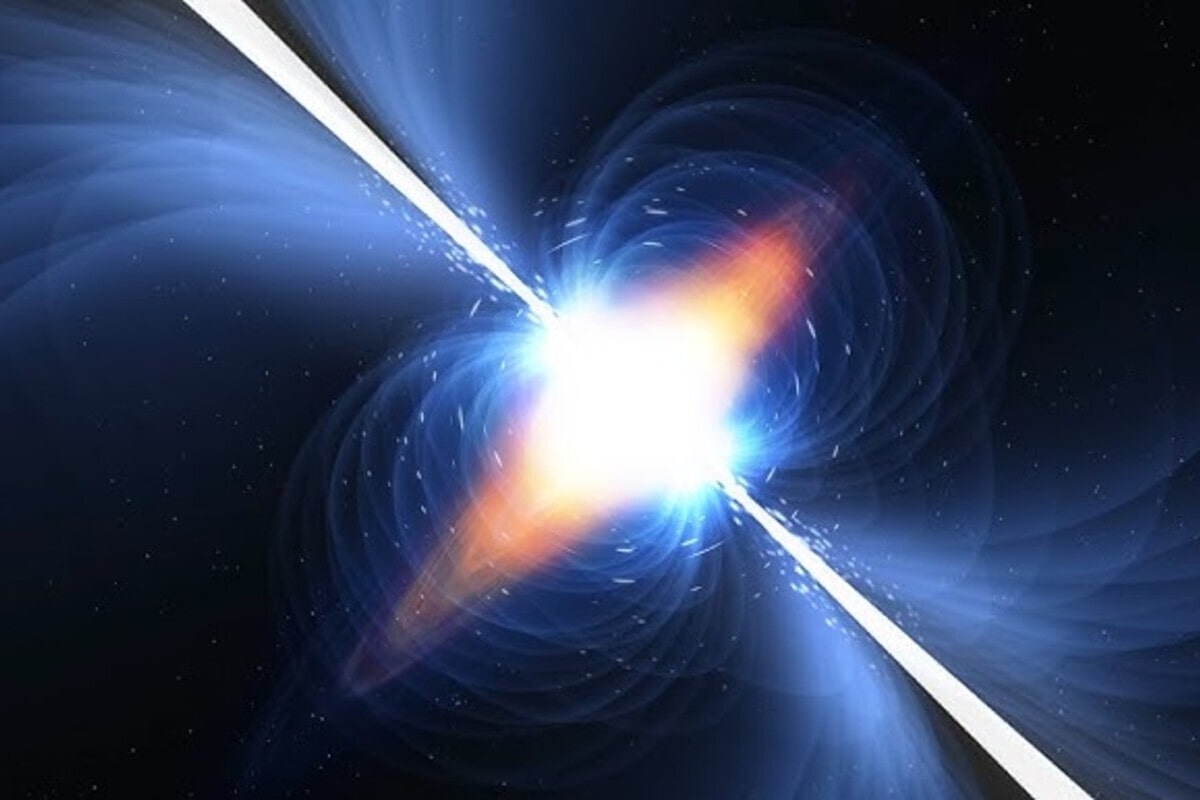Pulsars are among the most mysterious and at the same time the most precise objects in the Universe. Their discovery revolutionized astronomy and provided new insights into the nature of space, time and matter. These cosmic beacons help scientists study black holes, gravitational waves and test the laws of general relativity. Below is a collection of interesting facts about pulsars that you might not have known, but which reveal the astonishing world of deep space.
- Pulsars are neutron stars that rotate at very high speeds and emit radio waves from their magnetic poles. When these beams point toward Earth, we observe them as regular pulses. These signals resemble the flashes of a lighthouse that appear periodically in our line of sight. This effect is what gave pulsars their name.
- The first pulsar was discovered in 1967 by student Jocelyn Bell Burnell during radio observations. At first, the signals were thought to be artificial and were labeled LGM, meaning little green men. Later, it became clear that the source was a natural object with incredibly precise timing. This discovery marked a major milestone in astrophysics.
- Pulsars are formed after the explosion of a supernova, when the core of a massive star collapses into an extremely dense state. The mass of the star is concentrated in an object with a diameter of just a few dozen kilometers. The density is so extreme that one teaspoon of its material would weigh billions of tons. These are among the densest objects in the Universe, second only to black holes.
- Some pulsars rotate extremely fast, up to several hundred times per second. These are called millisecond pulsars and are considered some of the most stable natural clocks. Their accuracy even surpasses that of atomic clocks. Astronomers use them for precise timekeeping and experiments in fundamental physics.
- Pulsars have extremely strong magnetic fields, millions of times stronger than Earth’s magnetic field. These fields guide the emission beams from the magnetic poles. As the pulsar rotates and the magnetic axis does not align with the rotational axis, the signals reach Earth periodically. This creates the effect of regular pulses.
- Some pulsars are found in binary systems with other stars or even with black holes. In such systems, the pulsar can pull matter from its companion, which can affect its rotation. These interactions provide valuable insights into matter under extreme conditions. Binary pulsars are especially useful for testing predictions of general relativity.
- Pulsars are located thousands or even tens of thousands of light-years away from Earth. However, their powerful signals can still be detected with relatively small radio telescopes. They serve as cosmic lighthouses that help astronomers map the Galaxy. Pulsars are also used as reference points for interstellar navigation.
- Some pulsars suddenly change their rotation speed, a phenomenon known as a glitch. This suggests complex processes occurring within the ultra-dense core of the neutron star. Studying glitches helps scientists better understand the properties of neutron matter. These observations open new paths in nuclear physics.
- Magnetars are a special type of pulsar with exceptionally strong magnetic fields. They can release massive bursts of energy that affect even Earth’s ionosphere. One such event was recorded in 2004 and temporarily disrupted satellite operations. Magnetars are among the most energetic objects in the Universe.
- Some pulsars emit not only in the radio spectrum but also in X-rays and gamma rays. This allows them to be studied using various astronomical instruments. These multiwavelength pulsars provide a more complete picture of neutron star evolution. They bridge radio astronomy and high-energy astrophysics.
- In recent years, scientists have proposed using millisecond pulsars as navigational beacons for interstellar spacecraft. Their regularity allows for precise positioning in space. It is similar to GPS but on a galactic scale. This method could play a key role in the future of space exploration.
- Some pulsars are surrounded by nebulae that glow due to the energy emitted by the pulsar. A famous example is the Crab Nebula, a supernova remnant with a pulsar at its center. The pulsar’s pulses illuminate the surrounding gas and create a flickering effect. Such structures are natural laboratories for studying energy and matter interactions.
- More than 3000 pulsars have been discovered in our Galaxy, but scientists believe there are many more. Many remain undetected due to weak signals or unusual emission patterns. Future radio telescopes are expected to detect thousands of new pulsars. This will greatly expand our understanding of stellar evolution and galactic structure.
These incredible facts about pulsars show just how diverse and mysterious these cosmic objects are. They serve not only as subjects of observation but also as tools for testing the fundamental laws of physics. Studying pulsars allows us to explore conditions that cannot be reproduced on Earth. These remarkable objects continue to push the boundaries of our knowledge about the Universe.





